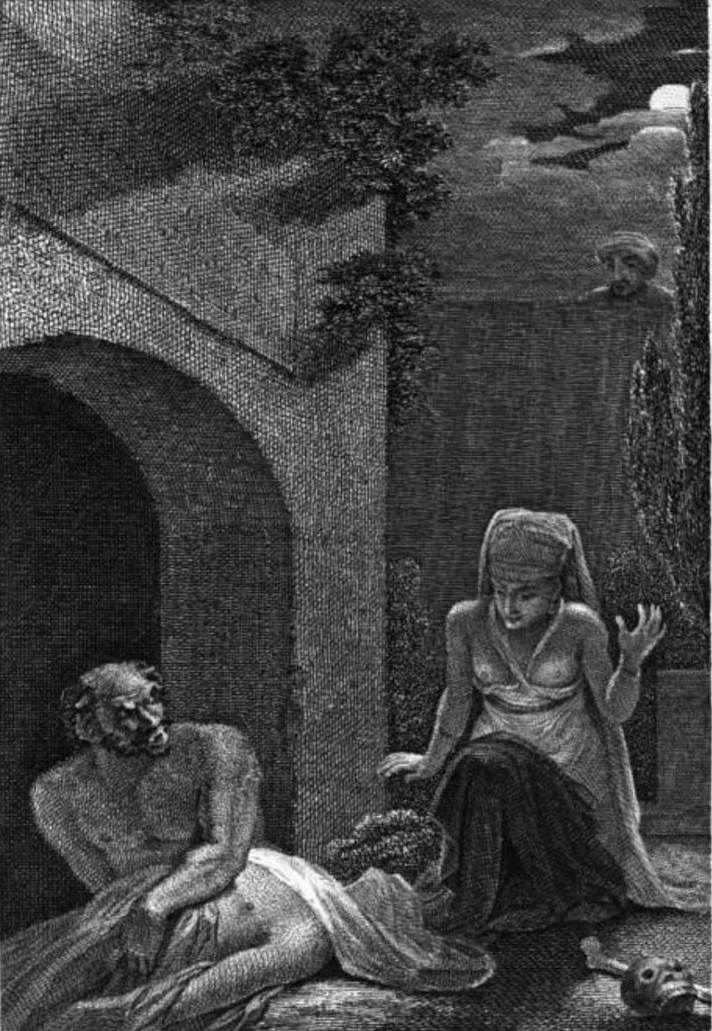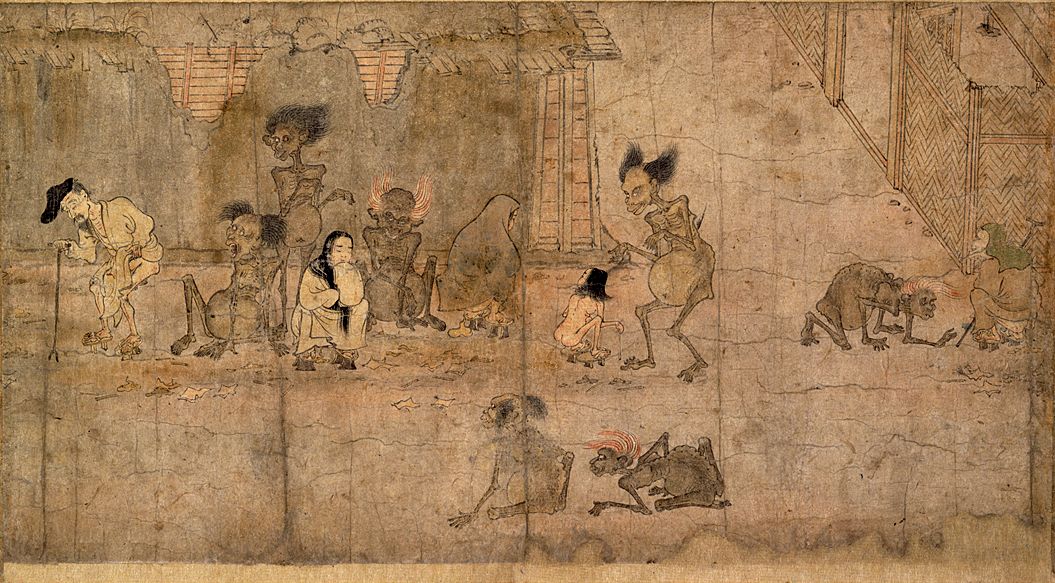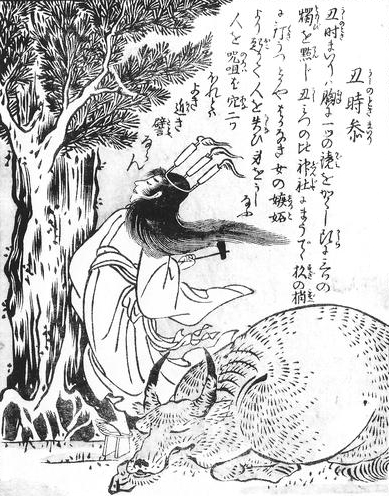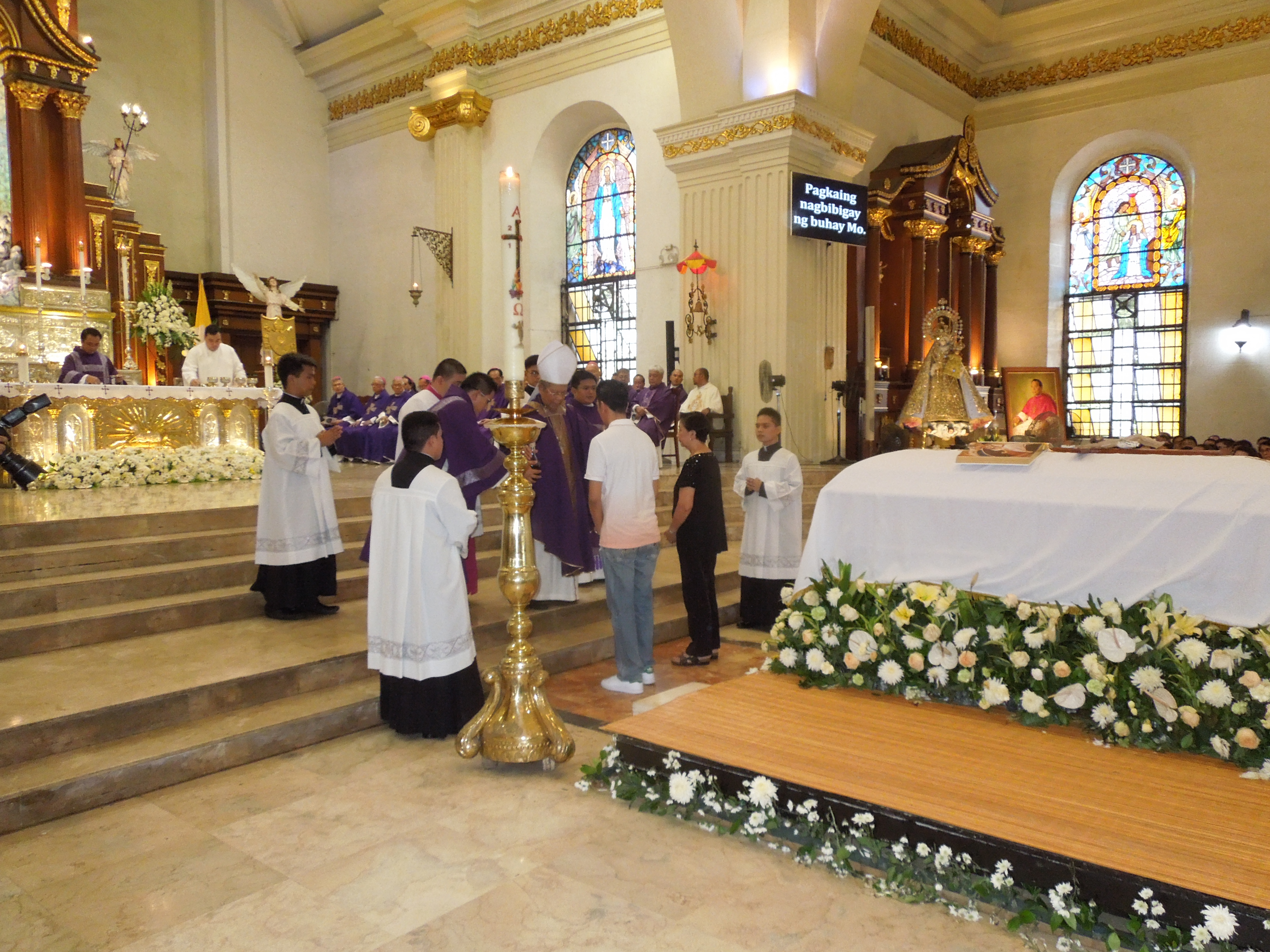|
Jikininki
appear in Lafcadio Hearn's '' Kwaidan: Stories and Studies of Strange Things'' (1904) as corpse-eating spirits. In Japanese Buddhism, ''jikininki'' ("human-eating ghosts"; pronounced ''shokujinki'' in modern Japanese), are similar to '' Gaki''/''Hungry ghost''; the spirits of greedy, selfish or impious individuals who are cursed after death to seek out and eat humans and human corpses. A similar story can be found as "Aozukin" in Ueda Akinari's ''Ugetsu Monogatari'' from 1776. Story It is said that there was a monk/priest, named Muso, who was traveling alone through the mountains in the Mino prefecture of Japan, when he lost his way. It was almost dark when he saw, up on a hill, an old , the home of solitary priests. He walked to the top of the hill and asked the inhabitant if he could stay the night. The only inhabitant was an old priest, who harshly refused Muso lodgings for the night; however, he told Muso that he could find food and a place to sleep down in a hamlet, nea ... [...More Info...] [...Related Items...] OR: [Wikipedia] [Google] [Baidu] |
Undead
The undead are beings in mythology, legend, or fiction that are deceased but behave as if they were alive. A common example of an undead being is a cadaver, corpse reanimated by supernatural forces, by the application of either the deceased's own Energy (esotericism), life force or that of a supernatural being (such as a demon, or other evil spirit). The undead may be Incorporeality, incorporeal (ghosts) or Human body, corporeal (mummy (undead), mummies, vampires, skeleton (undead), skeletons, and zombies). The undead are featured in the belief systems of most cultures, and appear in many works of fantasy fiction, fantasy and horror fiction. The term is also occasionally used for real-life attempts to Resurrection#Technological resurrection, resurrect the dead with science and technology, from early experiments like Robert E. Cornish's to future sciences such as "chemical brain preservation" and "cryonics." While the term usually refers to corporeal entities, in some cases (for ... [...More Info...] [...Related Items...] OR: [Wikipedia] [Google] [Baidu] |
Ghoul
In folklore, a ghoul (from , ') is a demon-like being or monstrous humanoid, often associated with graveyards and the consumption of human flesh. In the legends or tales in which they appear, a ghoul is far more ill-mannered and foul than goblins. The concept of the ghoul originated in pre-Islamic Arabian religion. Modern fiction often uses the term to label a specific kind of monster. By extension, the word "ghoul" is also used in a derogatory sense to refer to a person who delights in the macabre or whose occupation directly involves death, such as a gravedigger or graverobber. Etymology The English word ''ghoul'' is from the Arabic (), from () ."Ghoul, N." ''Oxford English Dictionary'', Oxford UP, December 2024, https://doi.org/10.1093/OED/2239227052. The term was first used in English literature in 1786 in William Beckford's Orientalist novel '' Vathek'', which describes the of Arabic folklore. This definition of the ghoul has persisted into modern times, wit ... [...More Info...] [...Related Items...] OR: [Wikipedia] [Google] [Baidu] |
Preta
''Preta'' (, ''yi dags''), also known as hungry ghost, is the Sanskrit name for a type of supernatural being described in Hinduism, Buddhism, Taoism, and Chinese folk religion as undergoing suffering greater than that of humans, particularly an extreme level of hunger and thirst. They have their origins in Indian religions and have been adopted into East Asian religions via the spread of Buddhism. Preta is often translated into English as " hungry ghost" from the Chinese and East Asian adaptations. In early sources such as the ''Petavatthu'', they are much more varied. The descriptions below apply mainly in this narrower context. The development of the concept of the preta started with just thinking that it was the soul and ghost of a person once they died, but later the concept developed into a transient state between death and obtaining karmic reincarnation in accordance with the person's fate. In order to pass into the cycle of karmic reincarnation, the deceased's family mus ... [...More Info...] [...Related Items...] OR: [Wikipedia] [Google] [Baidu] |
Hungry Ghost
Hungry ghost is a term in Buddhism and Chinese traditional religion, representing beings who are driven by intense emotional needs in an animalistic way. The term zh, c= 餓鬼, p=èguǐ, l=hungry ghost is the Chinese translation of the Sanskrit term ''preta'' in Buddhism. "Hungry ghosts" play a role in Chinese Buddhism, Taoism, and in Chinese folk religion. The term is not to be confused with the generic term for "ghost" or damnation, (i.e. the residual spirit of a deceased ancestor). The understanding is that people first become a regular ghost when they dieVenerable Yin-shun. ''The Way to Buddhahood''. Massachusetts: Wisdom Publications: 1998. and then slowly weaken and eventually die a second time.Teiser, Stephen F. ''The Ghost Festival in Medieval China''. New Jersey: Princeton University Press: 1988. Hungry ghosts, by contrast, are a much more exceptional case, and would only occur in very unfortunate circumstances, such as if a whole family were killed or when a family ... [...More Info...] [...Related Items...] OR: [Wikipedia] [Google] [Baidu] |
Segaki
The is a ritual of Japanese Buddhism, traditionally performed to stop the suffering of the such restless ghosts/monsters as , and --the dead who have no living relatives)--all ghosts tormented by an insatiable hunger. Alternatively, the ritual forces them to return to their portion of hell or keeps the spirits of the dead from falling into the realm of the gaki. The segaki may be performed at any time, but traditionally performed as part of the yearly '' Urabon'e'' ( ''Ullambana'') services in July to remember the dead and the segaki ritual for offering alms to specifically hungry gaki or muenbotoke, not for spirits of one's ancestor. The ritual is held at Buddhist temples and there is a custom to place segaki-dana (rack for gaki) or gaki-dana (shelf for gaki) at home, present offerings (traditionally rice and water) for hungry ghosts who are wandering in this world as muenbotoke during Urabon'e or O-bon. The segaki began as a way for Moggallana (Maudgalyāna in Sanskrit), on ... [...More Info...] [...Related Items...] OR: [Wikipedia] [Google] [Baidu] |
Ushi No Toki Mairi
or refers to a prescribed method of laying a curse upon a target that is traditional to Japan, so-called because it is conducted during the hours of the Ox (between 1 and 3 AM). The practitioner—typically a scorned woman—while dressed in white and crowning herself with an iron ring set with three lit candles upright, hammers nails into a of the Shinto shrine. In the modern-day common conception, the nails are driven through a straw effigy of the victim, impaled upon the tree behind it. The ritual must be repeated seven days running, after which the curse is believed to succeed, causing death to the target, but being witnessed in the act is thought to nullify the spell. The Kifune Shrine in Kyoto is famously associated with the ritual. Also variously called , , . Overview Sources say that common methods of the ritual developed during the Edo period (1603–1868)., citing The woman performing the curse is generally portrayed as dressed in white, with disheveled ... [...More Info...] [...Related Items...] OR: [Wikipedia] [Google] [Baidu] |
Ghost
In folklore, a ghost is the soul or Spirit (supernatural entity), spirit of a dead Human, person or non-human animal that is believed by some people to be able to appear to the living. In ghostlore, descriptions of ghosts vary widely, from an invisible presence to translucent or barely visible wispy shapes to realistic, lifelike forms. The deliberate attempt to contact the spirit of a deceased person is known as necromancy, or in Kardecist spiritism, spiritism as a ''séance''. Other terms associated with it are apparition, haunt, haint, phantom, poltergeist, Shade (mythology), shade, specter, spirit, spook, wraith, demon, and ghoul. The belief in the existence of an afterlife, as well as manifestations of the spirits of the dead, is widespread, dating back to animism or ancestor worship in pre-literate cultures. Certain religious practices—funeral rites, exorcisms, and some practices of Spiritualism (beliefs), spiritualism and ritual magic—are specifically designed to re ... [...More Info...] [...Related Items...] OR: [Wikipedia] [Google] [Baidu] |
Corpse
A cadaver, often known as a corpse, is a dead human body. Cadavers are used by medical students, physicians and other scientists to study anatomy, identify disease sites, determine causes of death, and provide tissue to repair a defect in a living human being. Students in medical school study and dissect cadavers as a part of their education. Others who study cadavers include archaeologists and arts students. In addition, a cadaver may be used in the development and evaluation of surgical instruments. The term ''cadaver'' is used in courts of law (and, to a lesser extent, also by media outlets such as newspapers) to refer to a dead body, as well as by recovery teams searching for bodies in natural disasters. The word comes from the Latin word ''cadere'' ("to fall"). Related terms include ''cadaverous'' (resembling a cadaver) and ''cadaveric spasm'' (a muscle spasm causing a dead body to twitch or jerk). A cadaver graft (also called “postmortem graft”) is the grafting of tis ... [...More Info...] [...Related Items...] OR: [Wikipedia] [Google] [Baidu] |
Japanese Ghosts
Japanese may refer to: * Something from or related to Japan, an island country in East Asia * Japanese language, spoken mainly in Japan * Japanese people, the ethnic group that identifies with Japan through ancestry or culture ** Japanese diaspora, Japanese emigrants and their descendants around the world * Japanese citizens, nationals of Japan under Japanese nationality law ** Foreign-born Japanese, naturalized citizens of Japan * Japanese writing system, consisting of kanji and kana * Japanese cuisine, the food and food culture of Japan See also * List of Japanese people * * Japonica (other) * Japanese studies , sometimes known as Japanology in Europe, is a sub-field of area studies or East Asian studies involved in social sciences and humanities research on Japan. It incorporates fields such as the study of Japanese language, history, culture, litera ... {{disambiguation Language and nationality disambiguation pages ... [...More Info...] [...Related Items...] OR: [Wikipedia] [Google] [Baidu] |
Buddhist Legendary Creatures
Buddhism, also known as Buddhadharma and Dharmavinaya, is an Indian religion and List of philosophies, philosophical tradition based on Pre-sectarian Buddhism, teachings attributed to the Buddha, a wandering teacher who lived in the 6th or 5th century Before the Common Era, BCE. It is the Major religious groups, world's fourth-largest religion, with about 500 million followers, known as Buddhists, who comprise four percent of the global population. It arose in the eastern Gangetic plain as a movement in the 5th century BCE, and gradually spread throughout much of Asia. Buddhism has subsequently played a major role in Asian culture and spirituality, eventually spreading to Western world, the West in the 20th century. According to tradition, the Buddha instructed his followers in a path of bhavana, development which leads to Enlightenment in Buddhism, awakening and moksha, full liberation from ''Duḥkha, dukkha'' (). He regarded this path as a Middle Way between extremes su ... [...More Info...] [...Related Items...] OR: [Wikipedia] [Google] [Baidu] |
Gashadokuro
Utagawa Kuniyoshi's , also known as ''Takiyasha the Witch and the Skeleton Spectre'' are Yōkai, mythical creatures in modern Japanese mythology. Description The Gashadokuro is a spirit that takes the form of a giant skeleton made of the skulls of people who died in the battlefield or of starvation/famine (while the corpse becomes a gashadokuro, the spirit becomes a separate yōkai, known as hidarugami.), and is 10 or more meters tall. Only the eyes protrude, and some sources describe them as burning yellow or green. Gashadokuro wanders around at 2:00 a.m. and attacks and eats humans when it sees them. When a Gashadokuro approaches, it is said to make a clattering sound with its teeth "Gachi Gachi." However they are also known to be stealthy when approaching humans they wish to eat. The following characteristics are not confirmed by Japanese data. The Gashadokuro are said to possess the powers of invisibility and indestructibility since it is composed of the bones of people who ... [...More Info...] [...Related Items...] OR: [Wikipedia] [Google] [Baidu] |
Requiem
A Requiem (Latin: ''rest'') or Requiem Mass, also known as Mass for the dead () or Mass of the dead (), is a Mass of the Catholic Church offered for the repose of the souls of the deceased, using a particular form of the Roman Missal. It is usually celebrated in the context of a funeral (where in some countries it is often called a Funeral Mass). Musical settings of the propers of the Requiem Mass are also called Requiems, and the term has subsequently been applied to other musical compositions associated with death, dying, and mourning, even when they lack religious or liturgical relevance. The term is also used for similar ceremonies outside the Catholic Church, especially in Western Rite Orthodox Christianity, the Anglo-Catholic tradition of Anglicanism, and in certain Lutheran churches. A comparable service, with a wholly different ritual form and texts, exists in the Eastern Orthodox and Eastern Catholic churches as well as some Methodist churches. The Mass and i ... [...More Info...] [...Related Items...] OR: [Wikipedia] [Google] [Baidu] |





